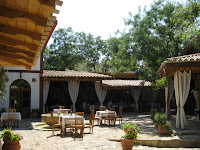







Street scenes, old town; Turkish restaurant; the Mosque; the Cathedral and lavish interior; Kainite Jewish memorial with prayer room and an engraved tablet.
Yevpatoria, or Evpatoria, is a very special place, like Bakchysaray. It's where the steppes meet the sea, as Barbara put it. No mountains here, but a rich history of different cultures that once made this fabulous Black Sea port their home. I have just learned about a brand new "Black Sea Studies" program at the International Hellenic University in Greece, testifying to the geo-political importance of the area, and after getting a glimpse of this ancient city I am tempted to sign up!
Barbara was a great guide. We wandered into the "old city," where Christian and Orthodox churches, a Muslim mosque, and a Kainite (Kenite) Jewish temple and monument exist near each other, towering over historic homes and restored buildings lovingly decorated and painted.
The Orthodox Cathedral, St. Nicholas, is an opulent building, lavishly decorated with paintings and icons, right up there with St. Mary's in Krakow and the Orthodox churches of Kyiv. Another church, proclaiming "Christ has Risen," stood amidst a lovely garden where Barbara and I sat on a bench and marveled at the sight. The 400-year-old Kahn mosque is elegant but I didn't put on the burka and head dressing necessary to go inside. Memories of Istanbul's Blue Mosque twirled around my head. We heard a Call to Prayer, however, as we toured the Kainite Jewish temple, a contemporary memorial to an ancient nomadic tribe of Turkish descent. I learned that this sect, which I knew nothing about, goes back to the time of Cain and Abel perhaps. It's mentioned in the Old Testament and was apparently spared from the horrors of the Holocaust, I'm not sure why. You walk under a beautiful grape arbor to get to the memorial, which features a prayer room and beautiful marble columns, medallians and tablets engraved with texts from the Torah.
The mixture of religious buildings, ancient homes and streets, and cultural artifacts in this relatively small area of Yevpatoria astonishes. I wanted to know more about how these different cultures and religions came and went, rose and fell. I wanted Loren nearby to tell me more. I think he would have felt at home here himself. I imagined Barbara, Loren and I, having lunch and tea outside at the lovely Turkish Restaurant Jeval.
Yevpartoria, Crimea, an international crossroads: Loren's soul might well reside here.
 into the mountains of southern Crimea is a dream, and I thought for some of the time that we were driving along Route 1 in California. The mountains rose and the sea emerged, the legendary Black sea, a crossroads between East and West for centuries . Barbara said it was "like Yosemite meeting the ocean," it was that beautiful.
into the mountains of southern Crimea is a dream, and I thought for some of the time that we were driving along Route 1 in California. The mountains rose and the sea emerged, the legendary Black sea, a crossroads between East and West for centuries . Barbara said it was "like Yosemite meeting the ocean," it was that beautiful. boats on the shimmering sea's horizon. It was a clear blue-sky day and the whole scene looked like a water-color painting.
boats on the shimmering sea's horizon. It was a clear blue-sky day and the whole scene looked like a water-color painting.






 Stalin’s repressive policies soon ended this “Golden Age” and resulted in further devastation of the Crimean Tatar people and culture, culminating in the mass overnight deportation on May 18, 1944, of all Crimean Tatars to Uzbekistan and other distant Soviet Republics. Over 46% of the Crimean Tatar population died during transport and in the subsequent camps, and almost all evidence of Crimean Tatar culture—mosques, place names, art and literature—were destroyed in Crimea, leading to the desired final solution of a “Crimea without Crimean Tatars.”
Stalin’s repressive policies soon ended this “Golden Age” and resulted in further devastation of the Crimean Tatar people and culture, culminating in the mass overnight deportation on May 18, 1944, of all Crimean Tatars to Uzbekistan and other distant Soviet Republics. Over 46% of the Crimean Tatar population died during transport and in the subsequent camps, and almost all evidence of Crimean Tatar culture—mosques, place names, art and literature—were destroyed in Crimea, leading to the desired final solution of a “Crimea without Crimean Tatars.”